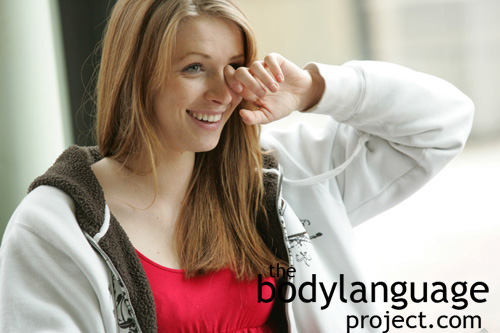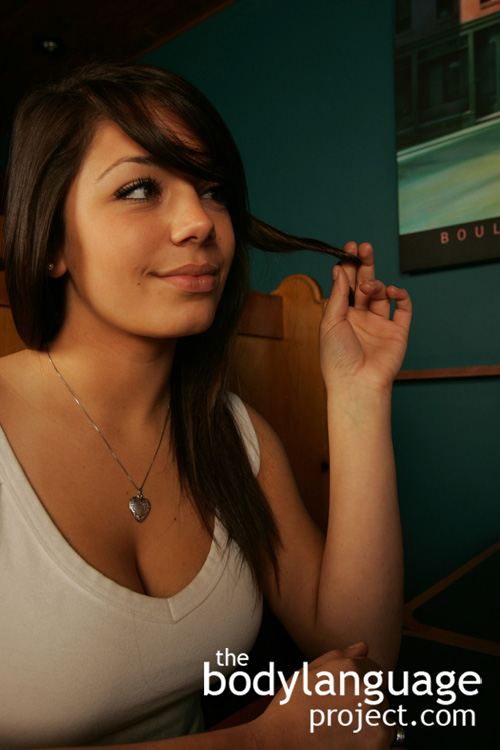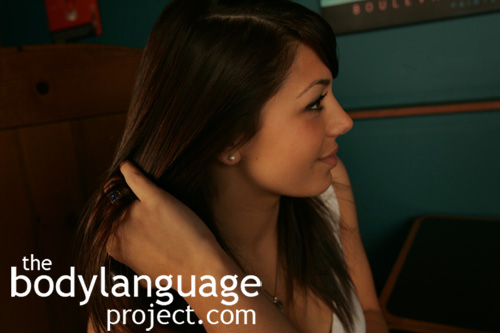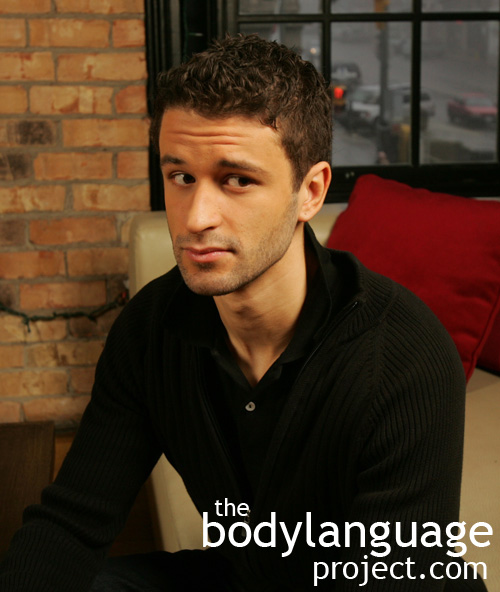Body Language of Happiness And Joy
Synonym(s): Joy, Happiness Facial Expression.
Description: Happiness is a combination of the happiness facial expression and associated happy body language.
The eyebrows are slightly raised forcing the eyelids to crinkle and show crows feet, eyes may sometimes narrow, the corners of the lips curl upward, the lips sometimes part to show upper teeth, cheeks puff up and bulge. See how a real smile is coupled with other body language in the cue cluster to produce happiness and joy.
In One Sentence: Happiness body language is a way the body shows other people that good things are going on inside a person’s mind, usually as a result of good things going on outside of their body.
How To Use it: Use joyful nonverbal expressions when you want others to see you in a positive light. Happiness is read by others as a sign of good health, prosperity and a good mental disposition. At times, healthy body language can be feigned in order to attract better quality partners, to make others jealous, or to hide insecurity. Some experts advocate faking positive body language as they believe that the body has a powerful influence over the mind (and vice versa). Therefore, moving the body is more joyful ways can sometimes produce desire emotional results. A joyful expression is also frequently contagious and copied in others. This gives the initiator of the happiness message a positive halo effect.
Context: General.
Verbal Translation: “I’m so happy my face is opening up to the whole world and my eyes are crinkling and smiling too. My teeth are bared as my mouth opens with joy.”
Variant: See Artificial Smile or Fake Smile to compare a real simile to a fake one as well as the Honest Smile or Duchenne Smile.
Cue In Action: You just knew she wasn’t faking it, her body was vibrating with joy and happiness, her face was beaming, her body was open and flowing.
Meaning and/or Motivation: Happiness is motivated by internal hormones, buffered and released by, external stimuli to create a body that is open, flowing, and beaming.
Happiness means that good things are happening to a person or that they are making good things happen to them. At times, negative things do happen, but a person who resists being negatively affected by them, shows a positive rather than pessimistic affect and one who is able to work through hardship. This is the exact opposite to those who view life pessimistically that look for the negative in all situations and expect good outcomes to be only temporary.
Cue Cluster: Watch for open body language such as arms and legs uncrossed, tension to be erased from the face, the eyes will twinkle, laugh lines appear in the corner of the eyes, cheeks raise and the teeth expose,
Body Language Category: Amplifier, Appease, Childlike playfulness, Emotional body language, Open body language, Open facial gestures.
Resources:
App, Betsy; Catherine L. Reed and Daniel N. McIntosh. Relative Contributions Of Face And Body Configurations: Perceiving Emotional State And Motion Intention. Cognition and Emotion. 2012. 26(4): 690-698.
http://bodylanguageproject.com/articles/facial-expressions-versus-bodily-expressions-nonverbal-communication/
Abel, Ernest L. and Michael L. Kruger. Smile Intensity in Photographs Predicts Longevity. Psychological Science. 2010. 21(4): 542-544. http://bodylanguageproject.com/articles/facebook-smile-predicts-life-satisfaction/
Borkenau, Peter; Steffi Brecke; Christine Möttig and Marko Paelecke. Extraversion is Accurately Perceived After a 50-ms Exposure to a Face. Journal of Research in Personality. 2009. 43: 703-706.
http://bodylanguageproject.com/articles/youre-extroverted-written-face-spot-extravert-nonverbals/
Bard, K. A. (2003). Development of emotional expressions in chimpanzees (Pan troglodytes). In P. Ekman, J. Campos, R. J. Davidson & F. B. M. De Waal (Eds.), Emotions inside out: 130 years after Darwin’s The Expression of the Emotions in Man and Animals (Vol. 1000, pp. 88-90). New York: Annals of the New York Academy of Sciences.
Baron, R. M., & Kenny, D. A. (1986). The moderator-mediator variable distinction in social psychological research: Conceptual, strategic, and statistical considerations. Journal of Personality and Social Psychology, 51(6), 1173-1882.
Biehl, M., Matsumoto, D., Ekman, P., Hearn, V., Heider, K., Kudoh, T., et al. (1997). Matsumoto and Ekman’s Japanese and Caucasian Facial Expressions of Emotion (JACFEE): Reliability Data and Cross-National Differences. Journal of Nonverbal Behavior, 21, 3-21.
Colonnesi, Cristina; Susan M. Bogels; Wieke de Vente and Mirjana Majdandzic. What Coy Smiles Say About Positive Shyness in Early Infancy. Infancy. 2013. 18(2): 202–220. ISSN: 1525-0008 print / 1532-7078 online
DOI: 10.1111/j.1532-7078.2012.00117.x
http://bodylanguageproject.com/articles/nonverbal-meaning-coy-smiles-infants/
Carroll E. 1994. Innate and universal facial expressions: Evidence from developmental and cross-cultural research Izard, Psychological Bulletin. 115(2): 288-299.
Daniel H. Lee, Reza Mirza, John G. Flanagan and Adam K. Anderson. Optical Origins of Opposing Facial Expression Actions. Psychological Science published online 24 January 2014 DOI: 10.1177/0956797613514451
http://bodylanguageproject.com/articles/eyes-and-facial-expressions-may-be-biologically-controlled-serve-a-real-non-emotional-purpose-says-research/
Dosmukhambetova, Dina and Antony S. R. Manstead. Fear Attenuated and Affection Augmented: Male Self-Presentation in a Romantic Context. Journal of Nonverbal Behavior. 2012. 36:135–147. DOI 10.1007/s10919-011-0126-1.
http://bodylanguageproject.com/articles/stifle-frown-expression-hot-chick-watching/
de Waal, F. B. M. (2003). Darwin’s legacy and the study of primate visual communication. In P. Ekman, J. Campos, R. J. Davidson & F. B. M. De Waal (Eds.), Emotions inside out: 130 years after Darwin’s The Expression of Emotion in Man and Animals (pp. 7-31). New York: New York Academy of Sciences.
Ekman, P., Friesen, W. V., O’Sullivan, M., Chan, A., Diacoyanni-Tarlatzis, I., Heider, K., et al. (1987). Universals and cultural differences in the judgments of facial expressions of emotion. Journal of Personality & Social Psychology, 53(4), 712-717.
Ekman, P., Levenson, R. W., & Friesen, W. V. (1983). Autonomic nervous system activity distinguishes among emotions. Science, 221(4616), 1208-1210.
Ekman, P., O’Sullivan, M., & Matsumoto, D. (1991a). Confusions about context in the judgment of facial expression: A reply to “The contempt expression and the relativity thesis.”. Motivation & Emotion, 15(2), 169-176.
Ekman, P., O’Sullivan, M., & Matsumoto, D. (1991b). Contradictions in the study of contempt: What’s it all about? Reply to Russell. Motivation & Emotion, 15(4), 293-296.
Elfenbein, H. A., & Ambady, N. (2002). On the universality and cultural specificity of emotion recognition: A meta-analysis. Psychological Bulletin, 128(2), 205-235.
Ekman, Paul. 1994. Strong evidence for universals in facial expressions: A reply to Russell’s mistaken critique Psychological Bulletin. 115(2): 268-287.
Ekman, Paul. 1986. A new pan-cultural facial expression of emotion. Source: Motivation and Emotion Ekman. 10(2): 159-168.
Ekman, Paul and Friesen, W. V. 1987. Universals and cultural differences in the judgments of facial expressions of emotion. Journal of Personality and Social Psychology. 53(4): 712-717.
Ekman, Paul; Friesen, Wallace V. 1971. Constants across cultures in the face and emotion. Journal of Personality and Social Psychology. 17(2): 124-129.
Ekman, Paul. 1972. Universals and cultural differences in facial expressions of emotion. In J. Cole (Ed.), Nebraska Symposium on Motivation, 1971. 19: 207-282. Lincoln: University of Nebraska Press.
Fulcher, J. S. “Voluntary” facial expression in blind and seeing children. Archives of Psychology, 1942. 38: 272.
Friesen, W. V. 1972. Cultural differences in facial expressions in a social situation: An experimental test of the concept of display rules. Unpublished doctoral dissertation, University of California, San Francisco.
Flack, William F., Jr. Peripheral Feedback Effects of Facial Expressions, Bodily Postures, and Vocal Expressions on Emotional Feelings. Cognition and Emotion. 2006. 20 (2), 177-195. DOI:10.1080/02699930500359617
http://bodylanguageproject.com/articles/body-and-facial-expressions-influence-mood/
Fairbairn, Catharine E.; Michael A. Sayette; Odd O. Aalen and Arnoldo Frigessi. Alcohol and Emotional Contagion: An Examination of the Spreading of Smiles in Male and Female Drinking Groups. Clinical Psychological Science. 2014. DOI: 2167702614548892
http://bodylanguageproject.com/articles/alcohol-social-lubricant-male-smiles/?preview=true
Gosselin, Pierre; Reem Maassarani; Alastair Younger and Mélanie Perron. Children’s Deliberate Control of Facial Action Units Involved in Sad and Happy Expressions. Journal of Nonverbal Behaviour. 2011. 35:225–242. DOI 10.1007/s10919-011-0110-9.
http://bodylanguageproject.com/articles/childrens-control-facial-actions-improve-age-create-accurate-emotional-expressions/
Girard, Jeffrey M.; Jeffrey F. Cohna; Mohammad H.Mahoor S.; Mohammad Mavadati;
Zakia Hammal; and Dean P. Rosenwalda. Nonverbal Social Withdrawal In Depression: Evidence From Manual And Automatic Analyses. Image and Vision Computing. 2013.
http://bodylanguageproject.com/articles/body-language-signals-withdrawal-depression/
Hareli, Shlomo; Noga Shomrat and Ursula Hess. Emotional Versus Neutral Expressions and Perceptions of Social Dominance and Submissiveness. Emotion. 2009 9(3): 378-384. DOI: 10.1037/a0015958
http://bodylanguageproject.com/articles/dominance-expression-conveyed-different-facial-expressions-men-women/
Hall, Jeffrey A. and Chong Xing. The Verbal and Nonverbal Correlates of the Five Flirting Styles. Journal of Nonverbal Behavior. 2015. 39:41–68. DOI 10.1007/s10919-014-0199-8
http://bodylanguageproject.com/articles/first-12-minutes-flirting-using-nonverbal-communication-study-reveals-26-body-language-cues-attraction/
Jessica L. Tracy and Alec T. Beall. Happy Guys Finish Last: The Impact of Emotion Expressions on Sexual Attraction Emotion. American Psychological Association. 2011; 11(6): 1379–1387
http://bodylanguageproject.com/articles/happy-guys-finish-last-happy-women-finish-first-says-new-study-on-sexual-attractiveness/
Levenson, R. W., Ekman, P., & Friesen, W. V. (1990). Voluntary facial action generates emotion-specific autonomic nervous system activity. Psychophysiology, 27(4), 363-384.
Levenson, R. W., Ekman, P., Heider, K., & Friesen, W. V. (1992). Emotion and autonomic nervous system activity in the Minangkabau of West Sumatra. Journal of Personality & Social Psychology, 62(6), 972-988.
McClure, Erin B 2000. A meta-analytic review of sex differences in facial expression processing and their development in infants, children, and adolescents
Psychological Bulletin. 126(3): 424-453.
Mead, M. 1975. Review of “Darwin and facial expression.” Journal of Communication, 25: 209-213.
Matsumoto, D. (1989). Cultural influences on the perception of emotion. Journal of Cross-Cultural Psychology, 20(1), 92-105.
Matsumoto, D. (1992). American-Japanese cultural differences in the recognition of universal facial expressions. Journal of Cross-Cultural Psychology, 23(1), 72-84.
Matsumoto, D. (2001). Culture and Emotion. In D. Matsumoto (Ed.), The Handbook of Culture and Psychology (pp. 171-194). New York: Oxford University Press.
Matsumoto, D., and Ekman, P. (1989). American-Japanese cultural differences in intensity ratings of facial expressions of emotion. Motivation & Emotion, 13(2), 143-157.
Matsumoto, D., Keltner, D., Shiota, M. N., Frank, M. G., & O’Sullivan, M. (2008). What’s in a face? Facial expressions as signals of discrete emotions. In M. Lewis, J. M. Haviland & L. Feldman Barrett (Eds.), Handbook of emotions (pp. 211-234). New York: Guilford Press.
Matsumoto, D., and Willingham, B. (2009). Spontaneous Facial Expressions of Emotion of Congenitally and Non-Congenitally Blind Individuals. Journal of Personality and Social Psychology, 96(1), 1-10.
Mesquita, B., and Frijda, N. H. (1992). Cultural variations in emotions: A review. Psychological Bulletin, 112, 197-204.
Mattson, Whitney I.; Jeffrey F. Cohn; Mohammad H. Mahoor; Devon N. Gangi and Daniel S. Messinger. Darwin’s Duchenne: Eye Constriction during Infant Joy and Distress. PLOS one. November 2013. 8(11): e80161. doi:10.1371/journal.pone.0080161.g001
http://bodylanguageproject.com/articles/duchenne-eye-constriction-associated-infant-cries-smiles-study/
Michalak, J., Rohde, K., Troje, N. F. How We Walk Affects What We Remember: Gait Modifications Through Biofeedback Change Negative Affective Memory Bias. Journal of Behavior Therapy and Experimental Psychiatry. 2015. 46:121-125.
http://bodylanguageproject.com/articles/walking-happy-leads-actual-happiness-game-emotions-body-language/
Nao, Misako Sawada and Motonobu Ishii. Development of the Movements Impressions Emotions Model: Evaluation of Movements and Impressions Related to the Perception of Emotions in Dance. Journal of Nonverbal Behavior. 2013. 37:107-121.
DOI 10.1007/s10919-013-0148-y
http://bodylanguageproject.com/articles/convey-emotion-nonverbally-dance-study/
Peleg, G., Katzir, G., Peleg, O., Kamara, M., Brodsky, L., Hel-Or, H., et al. (2006). Heriditary family signature of facial expression. Proceedings from the National Academy of Sciences, 103(43), 15921-15926.
Puccinelli, Nancy M. Putting Your Best Face Forward: The Impact of
Customer Mood on Salesperson Evaluation. Journal of Consumer Pyschology. 2006. 16(2). 156-162.
http://bodylanguageproject.com/articles/happy-face-doesnt-sell/
Raluca, Petrican; Christopher T. Burris and Morris Moscovitch. Shame, Sexual Compulsivity, and Eroticizing Flirtatious Others: An Experimental Study. Journal of Sex Research. 2015. 52(1), 98–109, 2015. DOI: 10.1080/00224499.2013.829796
http://bodylanguageproject.com/articles/coy-flirtatious-smile-eye-contact-leads-shame-sex/
Ruben, Molly A; Hall Judith, A and Mast, Marianne Schmid. Smiling in a Job Interview: When Less Is More. Journal of Social Psychology. 2014. http://bodylanguageproject.com/articles/smiling-much-can-kill-shot-job-study/
Russelll, James A.; Naoto Suzuki and Noriko Ishida. 1993. Canadian, Greek, and Japanese freely produced emotion labels for facial expressions. Motivation and Emotion. 17(4): 337 -351
Russell, James A. 1995. Facial Expressions of Emotion: What Lies Beyond Minimal Universality? Psychological bulletin. 118(3): 379-391.
Russell, James A. 1994. Is There Universal Recognition of Emotion From Facial Expression? A Review of the Cross-Cultural Studies. Psychological Bulletin. 115(1): 102-141.
Schneider, Sabrina; Andrea Christensen; Florian B. Häußinger; Andreas J. Fallgatter; Martin A. Giese and Ann-Christine Ehlis. Show Me How You Walk and I Tell You How You Feel – A Functional Near-Infrared Spectroscopy Study on Emotion Perception Based on Human Gait. NeuroImage. 2014, 85: 380-390 http://dx.doi.org/10.1016/j.neuroimage.2013.07.078.
http://bodylanguageproject.com/articles/show-me-how-you-walk-and-ill-tell-you-how-you-feel/
Susskind, Joshua M and Adam K Anderson. Facial Expression Form and Function. Communicative Integrative Biology. 2008. 1(2): 148–149. PMCID: PMC2686004
http://bodylanguageproject.com/articles/emotional-facial-expressions-evolve/
Seder, J. Patrick and Shigehiro Oishi. Intensity of Smiling in Facebook Photos Predicts Future Life Satisfaction. Social Psychological and Personality Science. 2012. 3(4): 407-413.
Shichuan Du; Yong Tao and Aleix M. Martinez. Compound facial expressions of emotion. Published online before print on March 31, 2014. DOI10.1073/pnas.1322355111
http://bodylanguageproject.com/articles/in-fact-there-are-more-than-21-facial-expressions/











